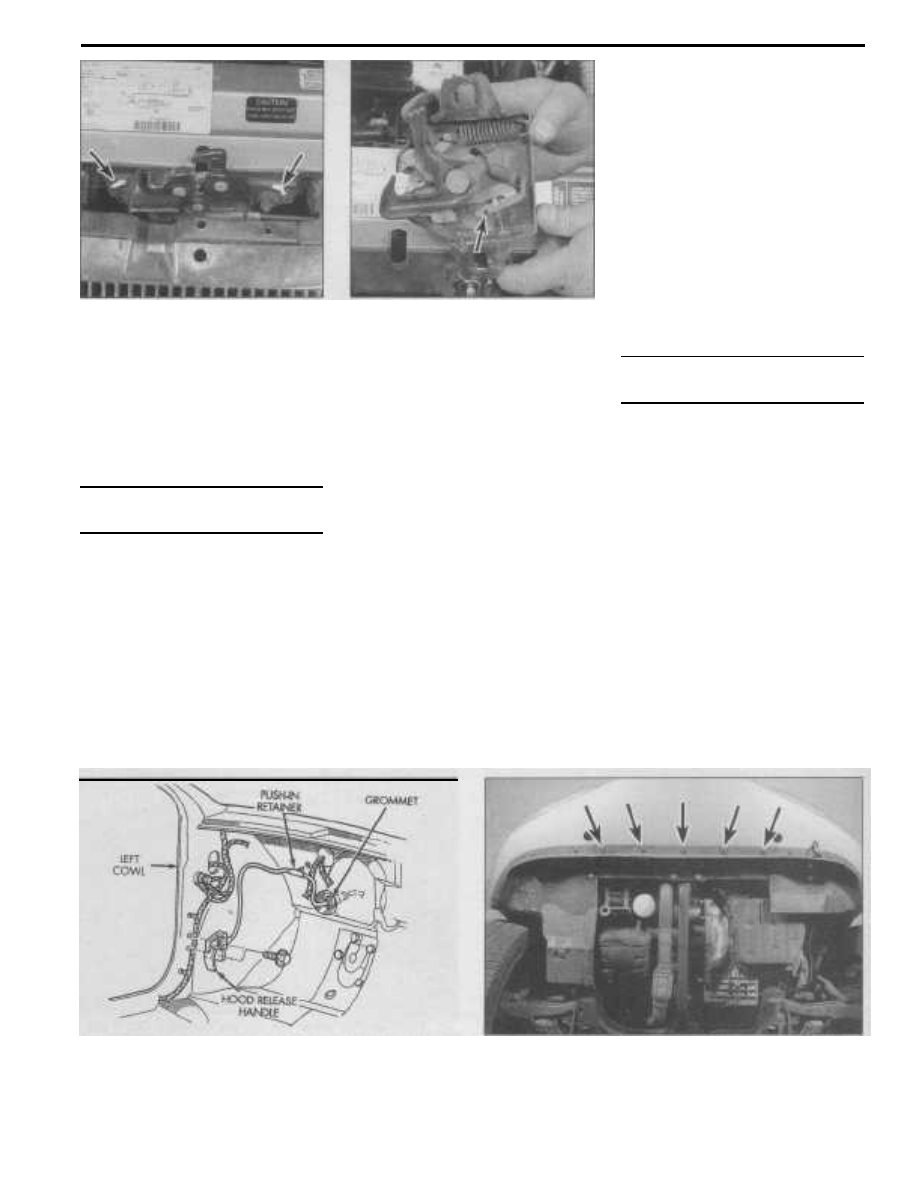Chrysler Cirrus, Dodge Stratus, Plymouth Breeze Haynes. Manual - part 32

11-6
Chapter 11
Body
10.2 For a reference point at installation,
mark the position of the hood latch
on the radiator support
alignment marks around the hood latch
assembly before loosening the mounting
nuts.
13
The hood latch assembly, as well as the
hinges, should be periodically lubricated with
white lithium-base grease to prevent sticking
and wear.
10
Hood latch and cable - removal
and installation
Warning: These models have airbags. Always
disable the airbag system before working in
the vicinity of the impact sensors, steering
column or instrument panel to avoid the pos-
sibility of accidental deployment of the
airbag, which could cause personal injury
(see Chapter 12).
Latch
Removal
Refer to illustrations 10.2 and 10.3
1
Open the hood and support it on the
prop rod.
2
Scribe alignment marks around the
hood latch assembly to aid alignment during
10.3 Slide the cable housing from the
key-hole slot in the hood latch, then slide
the cable through the slot (arrow) in the
release arm and separate the cable
from the hood latch assembly
installation (a permanent-type felt-tip marker
or paint will also work for this) (see illustra-
tion).
3
Remove the nuts and detach the latch
assembly from the radiator support, then dis-
connect the release cable from the hood
latch assembly (see illustration).
Installation
4
Installation is the reverse of removal.
Align the hood latch assembly with the marks
on the radiator support and then tighten the
nuts. Check hood latch operation. Readjust
as necessary.
Cable
Removal
Refer to illustration 10.8
5
Disconnect the release cable from the
hood latch (see Steps 1 through 3).
6
Detach the cable from the clips securing
it to the radiator support.
7
Inside the vehicle, remove the left front
kick panel to gain access to the hood release
handle bolts.
8
Remove the bolts securing the hood
release handle/cable assembly to the cowl
panel (see illustration).
9
Under the dash, locate and disengage
the push-in retainer and cable grommet from
the firewall.
10
Connect a piece of heavy string or flexi-
ble wire to the engine compartment end of
the cable, then from inside the vehicle, pull
the cable with string or wire attached through
the firewall into the vehicle. Disconnect the
string or wire from the old cable.
Installation
11
Connect the string or wire to the new
cable and carefully pull it through the firewall
into the engine compartment.
12
The remaining installation steps are the
reverse of removal.
11
Radiator grille (Cirrus models) -
removal and installation
Warning: These models have airbags. Always
disable the airbag system before working in
the vicinity of the impact sensors, steering
column or instrument panel to avoid the pos-
sibility of accidental deployment of the
airbag, which could cause personal injury
(see Chapter 12).
Removal
1
Open the hood and support it on the
prop rod.
2
Remove the front bumper with grille
attached (see Section 12).
3
Using an appropriate size drill, remove
the rivets securing the grille to the bumper
and separate the grille from the bumper.
Installation
4
Installation is the reverse of removal.
The grille can be reattached to the bumper
using rivets (if available) or screws, nuts and
washers. If threaded fasteners are used,
apply thread locking compound to the screw
threads.
10.8 Hood release cable and handle details as viewed
from inside the vehicle
12.5 Remove the five push-in fasteners (arrows) securing the
bottom of the front bumper to the radiator lower support